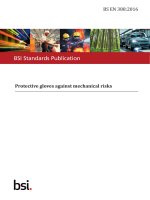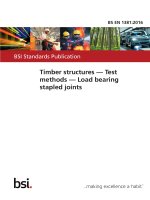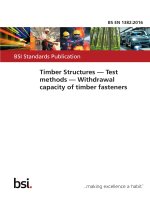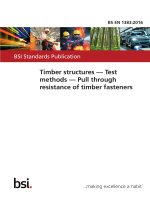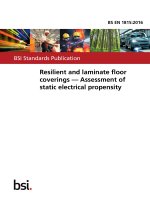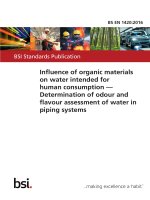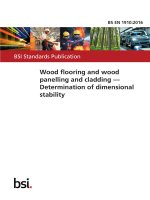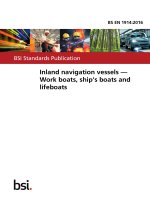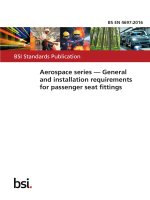Bsi bs en 61914 2016
Bạn đang xem bản rút gọn của tài liệu. Xem và tải ngay bản đầy đủ của tài liệu tại đây (1.92 MB, 34 trang )
BS EN 61914:2016
BSI Standards Publication
Cable cleats for electrical
installations
BRITISH STANDARD
BS EN 61914:2016
National foreword
This British Standard is the UK implementation of EN 61914:2016. It is
identical to IEC 61914:2015. It supersedes BS EN 61914:2009 which is
withdrawn.
The UK participation in its preparation was entrusted to Technical
Committee PEL/213, Cable management.
A list of organizations represented on this committee can be obtained on
request to its secretary.
This publication does not purport to include all the necessary provisions of
a contract. Users are responsible for its correct application.
© The British Standards Institution 2016.
Published by BSI Standards Limited 2016
ISBN 978 0 580 84075 3
ICS 29.120.20
Compliance with a British Standard cannot confer immunity from
legal obligations.
This British Standard was published under the authority of the
Standards Policy and Strategy Committee on 31 March 2016.
Amendments/corrigenda issued since publication
Date
Text affected
BS EN 61914:2016
EUROPEAN STANDARD
EN 61914
NORME EUROPÉENNE
EUROPÄISCHE NORM
February 2016
ICS 29.120.20
Supersedes EN 61914:2009
English Version
Cable cleats for electrical installations
(IEC 61914:2015)
Brides de câbles pour installations électriques
(IEC 61914:2015)
Kabelhalter für elektrische Installationen
(IEC 61914:2015)
This European Standard was approved by CENELEC on 2015-12-28. CENELEC members are bound to comply with the CEN/CENELEC
Internal Regulations which stipulate the conditions for giving this European Standard the status of a national standard without any alteration.
Up-to-date lists and bibliographical references concerning such national standards may be obtained on application to the CEN-CENELEC
Management Centre or to any CENELEC member.
This European Standard exists in three official versions (English, French, German). A version in any other language made by translation
under the responsibility of a CENELEC member into its own language and notified to the CEN-CENELEC Management Centre has the
same status as the official versions.
CENELEC members are the national electrotechnical committees of Austria, Belgium, Bulgaria, Croatia, Cyprus, the Czech Republic,
Denmark, Estonia, Finland, Former Yugoslav Republic of Macedonia, France, Germany, Greece, Hungary, Iceland, Ireland, Italy, Latvia,
Lithuania, Luxembourg, Malta, the Netherlands, Norway, Poland, Portugal, Romania, Slovakia, Slovenia, Spain, Sweden, Switzerland,
Turkey and the United Kingdom.
European Committee for Electrotechnical Standardization
Comité Européen de Normalisation Electrotechnique
Europäisches Komitee für Elektrotechnische Normung
CEN-CENELEC Management Centre: Avenue Marnix 17, B-1000 Brussels
© 2016 CENELEC All rights of exploitation in any form and by any means reserved worldwide for CENELEC Members.
Ref. No. EN 61914:2016 E
BS EN 61914:2016
EN 61914:2016
European foreword
The text of document 23A/786/FDIS, future edition 2 of IEC 61914, prepared by SC 23A “Cable
management systems” of IEC/TC 23 “Electrical accessories" was submitted to the IEC-CENELEC
parallel vote and approved by CENELEC as EN 61914:2016.
The following dates are fixed:
•
latest date by which the document has to be
implemented at national level by
publication of an identical national
standard or by endorsement
(dop)
2016-09-28
•
latest date by which the national
standards conflicting with the
document have to be withdrawn
(dow)
2018-12-28
This document supersedes EN 61914:2009.
Attention is drawn to the possibility that some of the elements of this document may be the subject of
patent rights. CENELEC [and/or CEN] shall not be held responsible for identifying any or all such
patent rights.
This standard covers the Principle Elements of the Safety Objectives for Electrical Equipment
Designed for Use within Certain Voltage Limits (LVD - 2006/95/EC).
Endorsement notice
The text of the International Standard IEC 61914:2015 was approved by CENELEC as a European
Standard without any modification.
In the official version, for Bibliography, the following notes have to be added for the standards indicated:
2
IEC 60068-2-75
NOTE
Harmonized as EN 60068-2-75.
IEC 60909-0
NOTE
Harmonized as EN 60909-0.
BS EN 61914:2016
EN 61914:2016
Annex ZA
(normative)
Normative references to international publications
with their corresponding European publications
The following documents, in whole or in part, are normatively referenced in this document and are
indispensable for its application. For dated references, only the edition cited applies. For undated
references, the latest edition of the referenced document (including any amendments) applies.
NOTE 1 When an International Publication has been modified by common modifications, indicated by (mod), the relevant
EN/HD applies.
NOTE 2 Up-to-date information on the latest versions of the European Standards listed in this annex is available here:
www.cenelec.eu
Publication
Year
Title
EN/HD
Year
IEC 60060-1
2010
High-voltage test techniques Part 1: General definitions and test
requirements
EN 60060-1
2010
IEC 60695-11-5
2004
Fire hazard testing EN 60695-11-5
Part 11-5: Test flames - Needle-flame
test method - Apparatus, confirmatory test
arrangement and guidance
2005
ISO 4287
1997
Geometrical Product Specifications
(GPS) - Surface texture: Profile method Terms, definitions and surface texture
parameters
EN ISO 4287
1998
ISO 4892-2
2006
Plastics - Methods of exposure to
laboratory light sources Part-2: Xenon-arc lamps
EN ISO 4892-2
2006
ISO 9227
2012
Corrosion tests in artificial atmospheres Salt spray tests
EN ISO 9227
2012
1)
1)
Superseded by EN ISO 4892-2:2013 (ISO 4892-2:2013).
3
–2–
BS EN 61914:2016
IEC 61914:2015 © IEC 2015
CONTENTS
FOREWORD ........................................................................................................................... 4
1
Scope .............................................................................................................................. 6
2
Normative references ...................................................................................................... 6
3
Terms, definitions and abbreviations ............................................................................... 6
4
General requirements ...................................................................................................... 8
5
General notes on tests .................................................................................................... 8
6
Classification ................................................................................................................... 9
6.1
6.1.1
6.1.2
6.1.3
6.2
6.3
6.3.1
6.3.2
6.3.3
6.3.4
6.3.5
6.4
According to material .............................................................................................. 9
Metallic ............................................................................................................ 9
Non-metallic .................................................................................................... 9
Composite ....................................................................................................... 9
According to maximum and minimum temperature .................................................. 9
According to resistance to impact ......................................................................... 10
Very light ....................................................................................................... 10
Light .............................................................................................................. 10
Medium ......................................................................................................... 10
Heavy ............................................................................................................ 10
Very heavy .................................................................................................... 10
According to type of retention or resistance to electromechanical forces or
both ...................................................................................................................... 10
6.4.1
General ......................................................................................................... 10
6.4.2
With lateral retention ..................................................................................... 10
6.4.3
With axial retention ........................................................................................ 10
6.4.4
Resistant to electromechanical forces, withstanding one short circuit ............ 10
6.4.5
Resistant to electromechanical forces, withstanding more than one
short circuit .................................................................................................... 10
6.5
According to environmental influences .................................................................. 10
6.5.1
Resistant to ultraviolet light for non-metallic and composite components ....... 10
6.5.2
Resistant to corrosion for metallic and composite components ...................... 10
7
Marking and documentation ........................................................................................... 10
7.1
Marking ................................................................................................................. 10
7.2
Durability and legibility .......................................................................................... 11
7.3
Documentation ...................................................................................................... 11
8
Construction .................................................................................................................. 11
9
Mechanical properties.................................................................................................... 11
9.1
Requirements ....................................................................................................... 11
9.2
Impact test ............................................................................................................ 12
9.3
Lateral load test .................................................................................................... 14
9.4
Axial load test ....................................................................................................... 15
9.5
Test for resistance to electromechanical force ...................................................... 17
9.5.1
General ......................................................................................................... 17
9.5.2
For cable cleats and intermediate restraints classified in 6.4.4 ...................... 19
9.5.3
For cable cleats and intermediate restraints classified in 6.4.5 ...................... 19
10 Fire hazards .................................................................................................................. 19
10.1
Flame propagation ................................................................................................ 19
BS EN 61914:2016
IEC 61914:2015 © IEC 2015
–3–
10.2 Smoke emission .................................................................................................... 20
10.3 Smoke toxicity ...................................................................................................... 20
11 Environmental influences ............................................................................................... 21
11.1 Resistance to ultraviolet light ................................................................................ 21
11.2 Resistance to corrosion ........................................................................................ 21
11.2.1
General ......................................................................................................... 21
11.2.2
Salt spray test ............................................................................................... 22
12 Electromagnetic compatibility ........................................................................................ 22
12.1 Electromagnetic emission ..................................................................................... 22
12.2 Inductive heating .................................................................................................. 22
Annex A (informative) Examples of cable cleats ................................................................... 23
Annex B (informative) Calculation of forces caused by short-circuit currents ....................... 24
B.1
Characteristics ...................................................................................................... 24
B.2
Specification of the test current ............................................................................. 25
B.3
Calculation of the mechanical forces between conductors ..................................... 25
Bibliography .......................................................................................................................... 28
Figure 1– Typical arrangement for impact test ...................................................................... 13
Figure 2 – Typical arrangements for lateral load test ............................................................. 15
Figure 3 – Typical arrangement for axial load test ................................................................. 16
Figure 4 – Typical assemblies for test for resistance to electromechanical force ................... 17
Figure 5 – Typical arrangement of three cables in trefoil formation ....................................... 18
Figure 6 – Typical arrangement of cables in flat formation .................................................... 18
Figure 7 – Typical arrangement of the needle-flame test ....................................................... 20
Figure B.1 – Short-circuit current of a far-from-generator short circuit with constant a.c.
component ............................................................................................................................ 24
Figure B.2 – Short-circuit current of a near-to-generator short circuit with decaying a.c.
component ............................................................................................................................ 25
Figure B.3 – Two parallel conductors .................................................................................... 26
Table 1 – Maximum temperature for permanent application .................................................... 9
Table 2 – Minimum temperature for permanent application ..................................................... 9
Table 3 – Impact test values ................................................................................................. 14
Table 4 – Resistance to corrosion ......................................................................................... 22
–4–
BS EN 61914:2016
IEC 61914:2015 © IEC 2015
INTERNATIONAL ELECTROTECHNICAL COMMISSION
____________
CABLE CLEATS FOR ELECTRICAL INSTALLATIONS
FOREWORD
1) The International Electrotechnical Commission (IEC) is a worldwide organization for standardization comprising
all national electrotechnical committees (IEC National Committees). The object of IEC is to promote
international co-operation on all questions concerning standardization in the electrical and electronic fields. To
this end and in addition to other activities, IEC publishes International Standards, Technical Specifications,
Technical Reports, Publicly Available Specifications (PAS) and Guides (hereafter referred to as “IEC
Publication(s)”). Their preparation is entrusted to technical committees; any IEC National Committee interested
in the subject dealt with may participate in this preparatory work. International, governmental and nongovernmental organizations liaising with the IEC also participate in this preparation. IEC collaborates closely
with the International Organization for Standardization (ISO) in accordance with conditions determined by
agreement between the two organizations.
2) The formal decisions or agreements of IEC on technical matters express, as nearly as possible, an international
consensus of opinion on the relevant subjects since each technical committee has representation from all
interested IEC National Committees.
3) IEC Publications have the form of recommendations for international use and are accepted by IEC National
Committees in that sense. While all reasonable efforts are made to ensure that the technical content of IEC
Publications is accurate, IEC cannot be held responsible for the way in which they are used or for any
misinterpretation by any end user.
4) In order to promote international uniformity, IEC National Committees undertake to apply IEC Publications
transparently to the maximum extent possible in their national and regional publications. Any divergence
between any IEC Publication and the corresponding national or regional publication shall be clearly indicated in
the latter.
5) IEC itself does not provide any attestation of conformity. Independent certification bodies provide conformity
assessment services and, in some areas, access to IEC marks of conformity. IEC is not responsible for any
services carried out by independent certification bodies.
6) All users should ensure that they have the latest edition of this publication.
7) No liability shall attach to IEC or its directors, employees, servants or agents including individual experts and
members of its technical committees and IEC National Committees for any personal injury, property damage or
other damage of any nature whatsoever, whether direct or indirect, or for costs (including legal fees) and
expenses arising out of the publication, use of, or reliance upon, this IEC Publication or any other IEC
Publications.
8) Attention is drawn to the Normative references cited in this publication. Use of the referenced publications is
indispensable for the correct application of this publication.
9) Attention is drawn to the possibility that some of the elements of this IEC Publication may be the subject of
patent rights. IEC shall not be held responsible for identifying any or all such patent rights.
International Standard IEC 61914 has been prepared by subcommittee 23A: Cable
management systems, of IEC technical committee 23: Electrical accessories.
This second edition cancels and replaces the first edition published in 2009. This edition
constitutes a technical revision.
This edition includes the following significant technical changes with respect to the previous
edition:
a) Additional declaration and test for lateral load retention depending on cleat mounting
orientation with associated new figures;
b) Additional declaration of the distance between the cable centres in any short-circuit test
and associated new figures;
c) Specification of the cable to be used in short-circuit testing and relaxation of the ambient
temperature limits for the test;
d) Additional requirement to photograph the short-circuit test arrangement before and after
the test and to record more complete details of the cable used;
BS EN 61914:2016
IEC 61914:2015 © IEC 2015
–5–
e) Revised parameters for the test of resistance to UV light.
This edition also includes the following editorial changes with respect to the previous edition:
f)
Revised and updated normative references and bibliography;
g) Editorial clarification of definitions;
h) Editorial clarification of procedures for selection of test samples and the testing of cleats
designed for more than one cable;
i)
Relaxation of some mandrel material requirements;
j)
Clarification of the inspection requirements following a short-circuit test and adding the
option of either a.c. or d.c. voltage testing following a second short-circuit;
k) Clarification that the resistance to corrosion test applies to all types of fixing;
l)
New cleat example illustration;
m) Limitations of use of the formulae in Annex B added.
The text of this standard is based on the following documents:
FDIS
Report on voting
23A/786/FDIS
23A/795/RVD
Full information on the voting for the approval of this standard can be found in the report on
voting indicated in the above table.
This publication has been drafted in accordance with the ISO/IEC Directives, Part 2.
In this standard, the following print types are used:
–
requirements proper: in roman type;
–
test specifications: in italic type;
–
notes: in smaller roman type.
The committee has decided that the contents of this publication will remain unchanged until
the stability date indicated on the IEC website under "" in the data
related to the specific publication. At this date, the publication will be
•
•
•
•
reconfirmed,
withdrawn,
replaced by a revised edition, or
amended.
IMPORTANT – The 'colour inside' logo on the cover page of this publication indicates
that it contains colours which are considered to be useful for the correct
understanding of its contents. Users should therefore print this document using a
colour printer.
–6–
BS EN 61914:2016
IEC 61914:2015 © IEC 2015
CABLE CLEATS FOR ELECTRICAL INSTALLATIONS
1
Scope
This International Standard specifies requirements and tests for cable cleats and intermediate
restraints used for securing cable in electrical installations. Cable cleats provide resistance to
electromechanical forces where declared. This standard includes cable cleats that rely on a
mounting surface specified by the manufacturer for axial and/or lateral retention of cables.
This standard does not apply to:
−
cable glands;
−
cable ties.
2
Normative references
The following documents, in whole or in part, are normatively referenced in this document and
are indispensable for its application. For dated references, only the edition cited applies. For
undated references, the latest edition of the referenced document (including any
amendments) applies.
IEC 60060-1:2010, High-voltage test techniques – Part 1: General definitions and test
requirements
IEC 60695-11-5:2004, Fire hazard testing – Part 11-5: Test flames – Needle-flame test
method – Apparatus, confirmatory test arrangement and guidance
ISO 4287:1997, Geometrical product specifications (GPS) – Surface texture: Profile method –
Terms, definitions and surface texture parameters
ISO 4892-2:2006, Plastics – Methods of exposure to laboratory light sources – Part 2: Xenonarc lamps
ISO 9227:2012, Corrosion tests in artificial atmospheres – Salt spray tests
3
Terms, definitions and abbreviations
For the purposes of this document, the following terms, definitions and abbreviations apply.
3.1
cable cleat
device designed to provide securing of cables when installed at intervals along the length of
cables
Note 1 to entry: A cable cleat is provided with a means of attachment to a mounting surface but does not rely on
an unspecified mounting surface for the retention of the cables. Examples of mounting surfaces that may be
specified are ladder, tray, strut (see Figure A.8) or rail. Where declared, cable cleats provide resistance to
electromechanical forces.
Note 2 to entry: See Figure A.1 to Figure A.9 for some examples of cable cleats. These examples do not limit the
use of other cable cleat designs that conform to the requirements of this standard.
BS EN 61914:2016
IEC 61914:2015 © IEC 2015
–7–
3.2
intermediate restraint
cable retaining device designed to be used with cable cleats, without being attached to the
mounting surface, to hold the cables together in order to provide resistance to
electromechanical forces
3.3
metallic
consisting of metal only
3.4
non-metallic
consisting of non-metallic material only
3.5
composite
consisting of metallic and non-metallic materials
Note 1 to entry:
Fibre reinforced resin materials are not considered to be composite under this definition.
3.6
short-circuit current
overcurrent resulting from a circuit condition in which the current flows through an abnormal
or unintended path of negligible impedance between live conductors, or between a live
conductor and an earth, having a difference in potential under normal operating conditions
3.7
peak short-circuit current
ip
maximum possible instantaneous value of the short-circuit current (see Annex B)
3.8
initial r.m.s. symmetrical short-circuit current
I" k
r.m.s. value of the a.c. symmetrical component of a short-circuit current, applicable at the
instant of the short circuit if the impedance remains at the zero-time value (see Annex B)
3.9
decaying (aperiodic) component of short-circuit current
i d.c.
mean value between the top and bottom envelope of a short-circuit current decaying from an
initial value to zero (see Annex B)
3.10
steady-state short-circuit current
Ik
r.m.s. value of the short-circuit current which remains after the decay of the transient
phenomena (see Annex B)
3.11
trefoil formation
formation of three cables so laid as to be mutually equidistant
Note 1 to entry:
(see Figure 5).
Note 2 to entry:
Viewed in cross-section, the lines joining the cable centres form an equilateral triangle
The formation is known as “close trefoil” formation when the cables are touching each other.
–8–
BS EN 61914:2016
IEC 61914:2015 © IEC 2015
3.12
flat formation
formation of a number of cables laid in a plane, usually with equal spacing between adjacent
cables (see Figure 6)
3.13
electromechanical forces
induced forces acting on current-carrying conductors
3.14
retention
limiting the lateral and/or axial movement of the cable
3.15
securing
fixing to or from a mounting surface or another product
3.16
environmental influences
effect of corrosive substances or solar radiation, etc.
4
General requirements
Products covered by this standard shall be so designed and constructed that, when
assembled and installed as for normal use according to the manufacturer’s instructions, they
ensure securing of cables as declared in accordance with Clause 6 and shall not cause
damage to the cable.
Compliance is checked by the relevant tests specified in this standard.
5
5.1
General notes on tests
Tests according to this standard are type tests.
−
Products of all sizes shall comply with Clause 8 and 9.1a).
−
For the requirements in 9.1b), 9.1c) and 9.1d) where there are a number of cleats in a
range, the range is divided into one or more types. In this case, the smallest and the
largest size of cleat of each type are tested.
−
The test for compliance with 9.1e) is performed on the set of samples selected as defined
in 9.5.1.
NOTE For guidance in determining types, cable cleats or intermediate restraints having material, construction
characteristics, and classifications according to Clause 6 below, in common, are considered to be the same type.
5.2
Unless otherwise specified, all tests shall be carried out on three new samples of each
size selected as specified in 5.1, assembled and installed as for normal use according to the
manufacturer’s or responsible vendor's instructions. Where a cable cleat is designed to
accommodate more than one cable the number, size and shape of the mandrels used in the
test shall represent the number, size and shape of the cables for which the cable cleat is
intended.
5.3
Tests on non-metallic and composite cleats and intermediate restraints shall not
commence earlier than 168 h after manufacture.
5.4
Unless otherwise specified, the tests shall be carried out at an ambient temperature of
(23 +−55 ) °C.
BS EN 61914:2016
IEC 61914:2015 © IEC 2015
–9–
5.5
Compliance with this standard is satisfied if all the applicable test requirements are
achieved. If only one of the samples does not satisfy a test due to a manufacturing fault, then
that test and any preceding one which may have influenced the results of the test shall be
repeated and also the tests which follow shall be made in the same required sequence on
another full set of samples, all of which shall comply with the requirements.
The applicant, when submitting the first set of samples, may also submit an additional set of
samples, which may be necessary should one sample fail. The test house should then,
without further request, test the additional set of samples and should only reject if a further
failure occurs. If the additional set of samples is not submitted at the same time, a failure of
one sample would entail rejection.
5.6
When toxic or hazardous processes are used, due regard shall be taken of the safety of
persons within the test area.
6
Classification
6.1
According to material
6.1.1
Metallic
6.1.2
Non-metallic
6.1.3
Composite
6.2
According to maximum and minimum temperature
Table 1 – Maximum temperature for permanent application
A. Maximum temperature
°C
+ 40
+ 60
+ 85
+ 105
+ 120
Table 2 – Minimum temperature for permanent application
B. Minimum temperature
°C
+5
−5
− 15
− 25
− 40
− 60
For temperature values above 120 °C and below −60 °C, the manufacturer or responsible
vendor may declare temperatures outside the values tabulated above.
– 10 –
6.3
BS EN 61914:2016
IEC 61914:2015 © IEC 2015
According to resistance to impact
6.3.1
Very light
6.3.2
Light
6.3.3
Medium
6.3.4
Heavy
6.3.5
Very heavy
6.4
According to type of retention or resistance to electromechanical forces or both
6.4.1
General
Manufacturers of cleats shall declare a classification under 6.4.2 and may also declare a
classification under 6.4.3. Manufacturers of cleats may also declare a classification under
6.4.4 or 6.4.5.
Manufacturers of intermediate restraints shall declare a classification under 6.4.4 or 6.4.5 in
association with cleats.
6.4.2
With lateral retention
6.4.3
With axial retention
NOTE
This value is for guidance purposes as it is not possible to replicate cables using mandrels.
6.4.4
Resistant to electromechanical forces, withstanding one short circuit
6.4.5
Resistant to electromechanical forces, withstanding more than one short
circuit
NOTE The intent for cable cleats and intermediate restraints classified under 6.4.5 is that after one short circuit
application, the cable cleat and intermediate restraints, if used, will continue to perform as designed and tested
according to this standard. The physical condition of the cable cleats and intermediate restraints after short circuit
application has only been evaluated under laboratory conditions. The continued use of the cable cleats and
intermediate restraints, if used, following an actual short circuit incident, is solely at the discretion of the party
responsible for the installation.
6.5
According to environmental influences
6.5.1
Resistant to ultraviolet light for non-metallic and composite components
6.5.1.1
Not declared
6.5.1.2
Resistant to ultraviolet light
6.5.2
Resistant to corrosion for metallic and composite components
6.5.2.1
Low
6.5.2.2
High
7
7.1
Marking and documentation
Marking
Each cleat and intermediate restraint shall be marked with
−
the manufacturer’s or responsible vendor’s name or logo or trademark;
−
the product identification or type.
BS EN 61914:2016
IEC 61914:2015 © IEC 2015
– 11 –
Where it is not possible to apply the marking directly onto the product, then the marking shall
be placed on the smallest supplied package.
7.2
Durability and legibility
Marking on the product shall be durable and easily legible to normal or corrected vision.
Compliance is checked by inspection and by rubbing the marking by hand for 15 s with a
piece of cloth soaked with water and again for 15 s with a piece of cloth soaked with
petroleum spirit.
After the test, the marking shall remain legible to normal or corrected vision.
Marking made by moulding, pressing or engraving is not subjected to the rubbing test.
NOTE
etc.
Examples of methods for applying marking are by moulding, pressing, engraving, printing, adhesive labels,
7.3
Documentation
The manufacturer or responsible vendor shall provide in their literature:
−
the classifications according to Clause 6;
−
the maximum and minimum cable or bundle diameters;
−
the lateral load for cleats declared under 6.4.2;
−
the axial load for cleats if declared under 6.4.3;
−
the method of assembly and installation including tightening torques, where appropriate,
and any limitation on mounting orientation for lateral retention.
Additionally, for cleats and/or intermediate restraints declared under 6.4.4 or 6.4.5, the
manufacturer or responsible vendor shall provide in their literature:
−
the peak short-circuit current;
−
the initial r.m.s. symmetrical short-circuit current;
−
the cable outside diameter and the distance between cable centres, S, used in the test in
9.5;
−
the maximum spacing, D, as shown in Figure 4.
Compliance is checked by inspection.
NOTE Some or all of this information may also be required to be provided on packaging or instruction sheets
supplied with the product.
8
Construction
The surfaces of cleats and intermediate restraints shall be free from sharp edges, burrs, flash,
etc. that are likely to damage cables or inflict injury to the installer or user.
Compliance is checked by visual and manual inspection of the surface.
9
9.1
Mechanical properties
Requirements
Cleats and intermediate restraints shall be:
– 12 –
BS EN 61914:2016
IEC 61914:2015 © IEC 2015
a) capable of accommodating the size or range of cable or cable bundle diameter declared
by the manufacturer or responsible vendor without cracking or breaking, or stripping of the
threads of screws or bolts;
Compliance is checked by measurement and by visual and manual inspection.
b) resistant to impact at the minimum declared temperature;
Compliance is checked by the test according to 9.2.
c) capable of withstanding the lateral load at the maximum declared temperature;
Compliance is checked by the test according to 9.3
d) capable of withstanding the axial load at the maximum declared temperature where
declared in 6.4.3;
Compliance is checked by the test in 9.4.
e) resistant to electromechanical forces, where declared in 6.4.4 or 6.4.5.
Compliance is checked by the test in 9.5.
9.2
Impact test
The impact test is carried out using a typical arrangement as shown in Figure 1. The
component transmitting the impact to the cleat or intermediate restraint shall have a spherical
radius of (300 +−55 ) mm at the point of contact.
BS EN 61914:2016
IEC 61914:2015 © IEC 2015
– 13 –
Dimensions in millimetres
1
∅10,5
A
A
2
6
R = 300
∅20
7
40
3
8,6
4
8,6
8,6
5
IEC
Key
1
Hammer
2
fall height (see Table 3)
3
rigid steel base
4
slightly rounded edges
5
section A – A
6
steel intermediate piece
7
Sample
Figure 1– Typical arrangement for impact test
Before the test, the samples are assembled onto a solid polyamide or metal test mandrel
having a diameter equivalent to the maximum declared diameter for which the cleat is
designed and mounted on a rigid support.
For cleats and intermediate restraints taking more than one cable, the appropriate number of
mandrels is used.
For metallic cleats and intermediate restraints, the test is carried out at ambient temperature.
For composite and non-metallic cleats and intermediate restraints, the samples are
conditioned at the declared lowest temperature according to Table 2 with a tolerance of
( +−22 ) °C for a period of (60 +05 ) min. The impact is applied within a period of (10 −02 ) s after
removal from the refrigerator.
BS EN 61914:2016
IEC 61914:2015 © IEC 2015
– 14 –
Each sample is placed in position on the steel base as shown in Figure 1. The energy value of
the hammer is as declared in Table 3.
The impact is applied at the weakest point of the cleat or intermediate restraint and the
direction of impact is radial to the centre of the mandrel nearest to the point of impact.
After the test, the samples shall show no signs of disintegration nor shall there be any cracks
or damage, visible to normal or corrected vision, that are likely to impair normal use. In case
of doubt, the samples are subjected to the test of 9.3.
Table 3 – Impact test values
Classification
Nominal
Impact
energy
Equivalent mass
Height
J
kg (± 2%)
mm (± 1%)
Very light
0,5
0,25
200
Light
1,0
0,25
400
Medium
2,0
0,5
400
Heavy
5,0
1,7
300
Very heavy
20,0
5,0
400
NOTE
The figures in Table 3 have been taken from IEC 60068-2-75.
9.3
Lateral load test
The cleat is mounted on a test rig as shown in Figure 2, or a similar arrangement. The
mounting surface can be made of steel or aluminium plate, plywood or other material. For the
purpose of applying the load, a rigid mandrel of circular, or other appropriate cross-section, is
positioned within the cleat’s aperture. For cleats and intermediate restraints taking more than
one cable, the appropriate number of mandrels is used. Where more than one mandrel is
used the load shall be applied to a mandrel furthest from the mounting surface. Care is taken
to ensure that the load acts through the centre line of the mandrel. The mandrel size is the
minimum for which the cleat is designed.
For metallic cable cleats, the declared load is applied gradually and held for a period of
(60 +05 ) min.
For non-metallic and composite cleats, the sample assembly is placed in a full draft
air-circulating oven. The tests are carried out after the oven temperature has reached and
maintained the declared maximum temperature from Table 1 with a tolerance of ( +−22 ) °C. The
load is applied gradually and then held for a period of (60 +05 ) min.
A cable cleat intended for a single mounting orientation shall be tested in that orientation and
that orientation shall be declared in the documentation.
A cable cleat intended for multiple mounting orientations shall be tested in each mounting
orientation using separate samples. The test load on one set of samples shall be applied
perpendicular to the mounting surface (Figure 2a or Figure 2b), and to the second set of
samples parallel to the mounting surface (Figure 2c or Figure 2d).
When it can be determined that a particular mounting orientation represents the most onerous
condition, the results of the tests in that orientation may represent all mounting orientations.
BS EN 61914:2016
IEC 61914:2015 © IEC 2015
– 15 –
Movement of the mandrel shall be less than 50 % of the mandrel diameter.
NOTE The test is meant to determine the lateral retention of the cleat and not the strength of the mounting
surface.
1
2
3
4
IEC
IEC
Figure 2a – Lateral load test with load applied
perpendicular to mounting surface on cleat with two
fixings
Figure 2b – Lateral load test with load applied
perpendicular to mounting surface on cleat with
single fixing
IEC
IEC
Figure 2c – Lateral load test with load applied parallel to
mounting surface on cleat with two fixings
Figure 2d – Lateral load test with load applied
parallel to mounting surface on cleat with single
fixing
Key
1
mounting surface
2
cleat
3
mandrel
4
direction of load
Figure 2 – Typical arrangements for lateral load test
9.4
Axial load test
The test is carried out using a mandrel with an overall cross section equivalent to the
minimum declared cable cross section for which the cleat is designed. The test mandrel shall
– 16 –
BS EN 61914:2016
IEC 61914:2015 © IEC 2015
have a diametrical tolerance of ( +−00,,22 ) mm for mandrels up to and including 16 mm diameter
and of ( +−00,,33 ) mm for larger diameters. In the case of non-circular cables, a profile is to be used
simulating the outer cable dimension, as declared by the manufacturer or responsible vendor.
For cleats and intermediate restraints taking more than one cable, the appropriate number of
mandrels is used. Where more than one mandrel is used the load shall be simultaneously
applied to all mandrels.
All mandrels shall have a surface roughness less than or equal to 7 µm Ra in accordance with
ISO 4287. For test temperatures below 105 °C, test mandrels may be solid polyamide or
metal. Metallic mandrels shall be used for test temperatures 105 °C and higher.
The cleat is mounted on a rigid mounting surface and assembled in the test rig as shown in
Figure 3, or a similar arrangement. The mounting surface can be made of steel or aluminium
plate, plywood or other material.
For metallic cable cleats, the declared load is applied gradually and held for a period of
(5 +01 ) min.
For non-metallic and composite cleats, the sample assembly is placed in a full draft
air-circulating oven. The tests are carried out after the oven temperature has reached and
maintained the declared maximum temperature from Table 1 with a tolerance of ( +−22 ) °C. The
load is applied gradually and held for a period of (5 +01 ) min.
After the test, the displacement of the mandrel(s) with respect to the cleat shall not be more
than 5 mm.
1
4
2
3
IEC
Key
1
cleat
2
mandrel
3
direction of load
4
mounting surface
Figure 3 – Typical arrangement for axial load test
BS EN 61914:2016
IEC 61914:2015 © IEC 2015
9.5
– 17 –
Test for resistance to electromechanical force
9.5.1
General
A short-circuit test is carried out as follows, using the manufacturer’s or responsible vendor's
declared values of peak short-circuit current(i p ) and initial r.m.s. symmetrical short-circuit
current(I" k ). One set of cleats of each type and of a size suitable for the test cable shall be
tested. The test is performed using unarmoured single core 600 V / 1 000 V stranded copper
conductor cable of either (35 +−55 ) mm or (50 +−55 ) mm diameter.
The temperature limits specified in 5.4 do not apply to this test. The test is carried out at the
prevailing ambient temperature on the declared arrangement at the declared short-circuit
level. The ambient temperature shall be recorded in the test report. Typical assemblies are
shown in Figure 4.
2
3
D
1
4
5
D
D
1
4
5
IEC
Key
1
supply end
2
Cable cleats
3
intermediate restraints
4
short-circuit busbar end
5
mounting surface
D
spacing
Figure 4 – Typical assemblies for test for resistance to electromechanical force
The arrangement of the cables is as shown in Figure 5 or Figure 6 with one cable per phase.
One end of each cable is connected to a three phase supply and the other end to a shortcircuiting busbar with all three phases being connected. The short-circuiting busbar shall be
insulated from earth (ground). The cable is restrained at a minimum of 5 positions along the
cable run. Where intermediate restraints are used, at least 4 cleats and at least 3
intermediate restraints shall be used. Cleats and intermediate restraints, where used, shall be
equally spaced. The cleats are fixed to a mounting surface defined by the manufacturer (e.g.
cable ladder) which shall be selected with regard to the forces likely to occur during the test.
BS EN 61914:2016
IEC 61914:2015 © IEC 2015
– 18 –
S
S
S
IEC
Key
S
cable centre spacing
Figure 5 – Typical arrangement of three cables in trefoil formation
S
S
IEC
Key
S
Cable centre spacing
Figure 6 – Typical arrangement of cables in flat formation
Care is taken to ensure the cross-sectional area of the cable is adequate for the magnitude
and duration of the test current which shall be chosen so that the I 2 t (thermal stress) rating of
the cable used is not exceeded.
The test report shall contain the following information:
–
the manufacturer’s or responsible vendor’s catalogue references of the cable cleat and
intermediate restraint (where used);
–
the assembly details showing:
•
the number of cleats and their spacing, D;
•
the number of intermediate restraints (where used) and their spacing, D;
•
the cable centre spacing, S;
–
cable conductor diameter, insulation thickness, external diameter and markings
–
a pre-test photograph of the test assembly and a post-test photograph documenting the
condition of the cable cleats, and intermediate restraints if used
–
the test duration;
–
the ambient temperature during the test.
If the test station has to undertake a calibration test, action is taken to ensure that the test
installation is not affected.
The cables of the test arrangement are subjected to a three phase short circuit of duration of
not less than 0,1 s. The duration of the test is recorded.
BS EN 61914:2016
IEC 61914:2015 © IEC 2015
– 19 –
Care must be taken to ensure that there is adequate restraint for the cables at each end of
the cable run to be tested.
Annex B may be used to calculate the theoretical forces that may be created during short
circuits in order to plan testing.
9.5.2
For cable cleats and intermediate restraints classified in 6.4.4
Cleats and intermediate restraints classified under 6.4.4 shall comply with the following
requirements:
−
there shall be no failure that will affect the intended function of holding the cables in place;
−
the cable cleats and the intermediate restraints, if used, shall be intact with no missing
parts including all devices used to secure the cleats to the mounting surface;
−
there shall be no cuts or damage visible to normal or corrected vision to the outer sheath
of each cable caused by the cable cleats or by the intermediate restraints, if used.
9.5.3
For cable cleats and intermediate restraints classified in 6.4.5
Cleats and intermediate restraints classified under 6.4.5 shall comply with the inspection
requirements of 9.5.2 after the first and after the second short-circuit applications.
After a second short-circuit application, a voltage withstand test is performed by applying a
minimum test voltage of 2,8 kV d.c. or 1,0 kV a.c. for a period of (60 +05 ) s according to the
provisions of IEC 60060-1:2010, Clause 5, Tests with direct voltage or Clause 6, Tests with
alternating voltage. The voltage withstand test shall be administered between the cable cores,
which should be connected together, and the mounting frame. The mounting frame shall be
bonded to the earthing system. The cable jackets and mounting frame shall be pre-wetted
with sufficient water to facilitate a current leakage path along the outer jacket for (2+01 ) min
before the test begins.
The cables shall meet the requirements of the voltage withstand test without failure of the
insulation.
10 Fire hazards
10.1
Flame propagation
Non-metallic and composite cable cleats and intermediate restraints shall have adequate
resistance to flame propagation.
Compliance is checked by the following test.
Using an arrangement as shown in Figure 7, the sample shall be submitted to the needleflame test as specified in IEC 60695-11-5 with the following additional information:
−
the flame shall be applied to the outer surface of the sample,
−
the time of application shall be (30 +−10 ) s,
−
the underlying layer shall consist of three layers of tissue paper,
−
there shall be a single application of the flame.
The sample shall be deemed to have passed the test if:
−
30 s after the test flame is removed, there is no flaming of the sample,
−
there is no ignition of the tissue paper.
BS EN 61914:2016
IEC 61914:2015 © IEC 2015
– 20 –
Dimensions in millimetres
1
45° ± 2°
2
200 ± 5
5±1
3
4
IEC
Key
1
cleat
2
burner
3
stand
4
tissue paper
Figure 7 – Typical arrangement of the needle-flame test
10.2
Smoke emission
The smoke emissions from cleats and intermediate restraints need not be considered because
of their small size and quantity in normal use.
10.3
Smoke toxicity
The smoke toxicity from cleats and intermediate restraints need not be considered because of
their small size and quantity in normal use.
BS EN 61914:2016
IEC 61914:2015 © IEC 2015
– 21 –
11 Environmental influences
11.1
Resistance to ultraviolet light
Cleats and intermediate restraints classified according to 6.5.1.2 shall be subjected to
ultraviolet light (UV) conditioning according to the following requirements.
When the product is provided in more than one colour, the colour having the heaviest organic
pigment loading shall be subjected to this test. The samples tested are considered
representative of the entire colour range.
Samples shall be mounted in the ultraviolet light apparatus in a convenient manner suitable
for the product to be tested and the test equipment and so that the samples do not touch each
other.
The samples are to be exposed for a minimum of 700 h to Xenon-arc, Method A, Cycle 1 in
accordance with ISO 4892-2:2006. There shall be continuous exposure to light and
intermittent exposure to water spray. The cycle shall consist of 102 min without water spray
and 18 min with water spray. The apparatus shall operate with a water-cooled xenon-arc
lamp, borosilicate glass inner and outer optical filters, a spectral irradiance of
(0,51+−00..02
02 ) W/(m2•nm) at 340 nm and a black-standard temperature of
(63 +−33 ) °C. The
temperature of the chamber shall be (38 +−33 ) °C. The relative humidity in the chamber shall be
10
(50 +−10
) %.
Following the exposure, the samples shall be held for a minimum of 30 min under ambient
conditions.
After UV exposure, the samples shall show no signs of disintegration nor shall there be any
cracks or damage, visible to normal or corrected vision. The samples shall then be subjected
to the impact test, as described in 9.2 and shall comply with the impact test requirements.
NOTE
Cleats that comply with IEC 61914:2009 do not need to be re-tested.
11.2
Resistance to corrosion
11.2.1
General
Metallic or composite cleats and intermediate restraints shall have adequate resistance to
corrosion.
Compliance is determined by the test in 11.2.2 unless otherwise specified below.
Metallic or composite cleats and intermediate restraints, including fixings such as nuts, bolts,
screws and washers, made of non-ferrous metals, cast-iron, malleable-iron or stainless steel
containing at least 16 % chromium need not be tested and are assumed to meet the
classification for high resistance to corrosion. Stainless steel containing at least
13 % chromium is assumed to meet the classification for low resistance to corrosion and need
only be tested where declared in accordance with 6.5.2.2 for high resistance. Where corrosion
protection is provided by a layer of zinc equal to or greater than that specified in Table 4,
measurement of the zinc layer is required without the need to carry out further testing.
The mean and minimum thickness shall be determined by taking five measurements over the
plated surface.
Fixings, such as nuts, bolts, screws and washers, shall not be subjected to the test in 11.2.2,
however, the presence of a protective coating is required.
